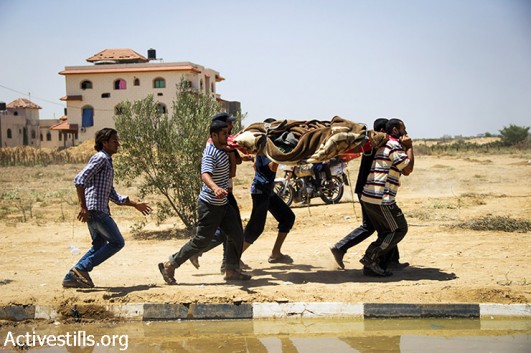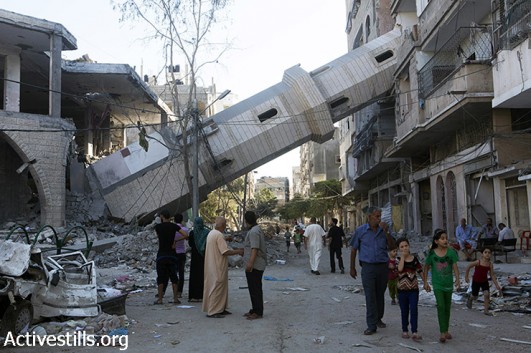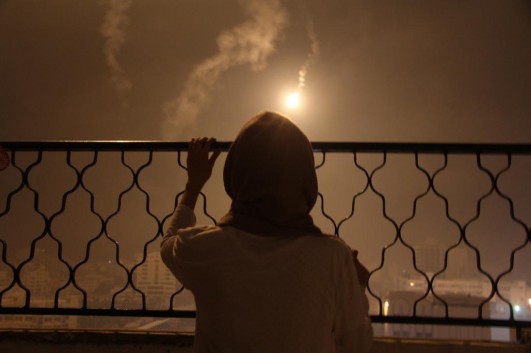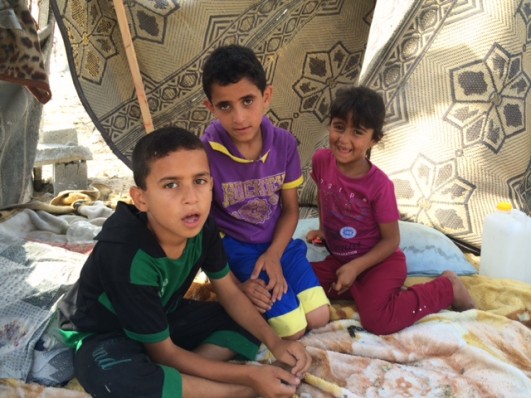In the tragedy that is the Middle East, we Palestinians have played two roles – the victim or the vilified. But Gaza is changing all that. Gaza is fighting back.
“You want to go where?”
My colleague and I have just boarded a taxi and named our destination– Rafah. Two days after the Israeli military had sealed Gaza’s southernmost town, claiming Hamas fighters had kidnapped one of its own, few images had emerged of the ensuing destruction. We wanted to see for ourselves.
We were not alone, of course. Thousands of families displaced from points north, east and south along Gaza’s border with Israel have seized any lull in the bombing to try and return to their homes, to survey the damage and salvage what they can from the rubble. That day, the Israelis announced that they would grant a limited respite – everywhere but Rafah.
Abu Deema, our driver, hears the word, tightens his grip on the steering wheel, and nods his head. “Ok,” he says, “yallah.” The Arabic expression is a conjunction of sorts, two words made one, meaning literally: “Oh, God.” In day-to-day conversation, though, yallah means “let’s go.”

The day-to-day here is filled with the makeshift tactics of civilians in war. The aim is simple: to survive. Before he shifts into drive, Abu Deema reaches over my knees and into the glove compartment, pulls out a roll of red tape, and hops out of the car. He is marking the hood, the doors, the trunk, the roof – all with the letters “TV.” This and a simple prayer – “in the name of God, the merciful, the gracious” – are his contingencies. We make haste, the sea to our right, the F-16s in flight.
I have been to Gaza before but never under these circumstances. This time, as a group of journalists and I walked the long stretch between the Israeli and Palestinian sides of the Erez crossing, we could hear tanks shelling Gaza City, where we would be staying. On the bus ride in, we saw entire neighborhoods abandoned in the so-called buffer zone. And as we approached our destination, long lines of people queued to buy bread, their cars plastered with the same two letters – to try and spare them from the machines overhead.
To the outsider, nothing about the scenes is ordinary. But to the 1.8 million people of Gaza, this is the look of life going on. There is a lesson here, I think. In the tragedy that is the Middle East, we Palestinians have played two roles – the victim or the vilified. But Gaza is changing all that. Gaza is fighting back.
Scene: I am standing in the rubble of the Munasra family home, within earshot of Israeli tanks that, a week earlier, had gutted it. The pockmarked walls are charred and peeling. Two schoolbooks – one on the life of Muhammad, the other Moses – are lying atop a mound of crumbled concrete and dust.
As my colleague and I survey the damage, a young man, the family’s first-born, brings us juice. It’s an act of hospitality so leavened in the Arab mind that it leaves him blind to the irony. “I’m sorry,” he says. “There’s nowhere to sit.” My colleague and I catch each other’s eyes. There are tears welling. The young man sees this and smiles: “What are we supposed to do? Bow down?”
This is Shejaiya, the eastern Gaza town that has endured some of the most devastating Israeli shelling these past weeks. With so many landmarks leveled – the mosque at the corner, the vegetable vendor by the curb – even its longtime residents can’t make out where the streets used to be.
And yet there they are, excavating what’s left – a photo album, a plastic vase, an apron their mother, now martyred, used to wear. Again, I think: If there’s one thing abiding in this battered place, it is this. Gaza’s Palestinians refuse to be victims.

Another colleague, a 22-year-old freelance journalist, awoke on the 27th day of this war-of-one-army and decided to get dressed. Lara donned a purple-petaled blouse, washed her hair in unheated water and painted her nails peach. She traced her lips, just so, in pink, and stiffened her lashes black. And then she waited – waited for the next attack.
Beside her is Assad, who rarely speaks. He, too, is listening to the drones overhead and waiting for the coming airstrike. His brother, Jehad, is standing at the window, eyeing the sky and listening for the F-16s. Sometimes, they fly so low you can hear the approach – which is good, because it helps you brace for the blast.
Assad is scrolling through the photos he’s taken so far. One prompts him to speak. “The day they hit Shati,” he says, referring to a strike on the refugee camp there, “I was at the hospital and saw the kids.” There were eight of them that day, the first day of Eid. And one, Assad tells me, had his head blown off. “But in his hand, his small right hand, he still held a shekel” – his fare for the carousel ride he never took.
Assad doesn’t cry. He just stares off into the middle distance.
Later that night, around 4 a.m., we hear two “knocks” on the empty university building across the street. Jehad and Lara grab their cameras, and I join them at the window. A missile is coming. It’s just a matter of minutes now. We joke about who will keep their hands steadiest. Lara pokes fun at my thick-rimmed glasses.
When it comes, it hits 150 meters away. Jehad captures it best, but Lara gets to post it. As day breaks, we contemplate sleep. There is no need for alarms. Soon enough, the bombs will wake us. Death will come, and life will go on.

When I’m asked how people cope here, I think of these situations and struggle to convey them. Part of the struggle is about not wanting to simplify things or presume too much. The horrors, after all, are also deeply personal. But everywhere I have been, the Palestinians of Gaza have insisted their story be told. And so here’s another:
Today, north of here, there is a family – one of thousands – sitting beneath a tree that is across from the rubble that was their home. There are three children there: two Ahmads, one 10, the other eight. And Hala, who is six. If they had no safe-haven from the bombing before, they have even less of one now. And yet they survive, somehow.
And in that way, they, too, are fighting back.

Related:
Gaza’s half-million internally displaced
How will Gaza’s children carry their scars into adulthood?
Gaza dispatch: Why the destruction in Beit Hanoun is different


